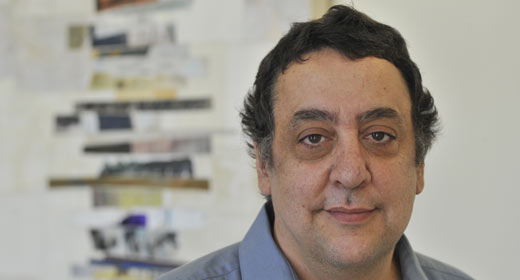
John DiNardo (AB ’83, MPP ’84) has read J.K. Rowling’s Harry Potter series in every language he can comprehend—English, Italian, and French—so perhaps it’s not surprising that when DiNardo had to take time off from teaching to be treated for acute myelogenous leukemia, his students referred to the book in their messages of encouragement. DiNardo’s master’s students Photo-shopped a film poster, casting DiNardo as Snape. His doctoral students, he says, were more likely to cast him as Dumbledore (his definitive preference).
Now DiNardo is back in the classroom teaching “Advanced Program Evaluation” to master’s and doctoral students of economics, policy, higher ed, health policy, and other disciplines. As a labor economist with interests in unions and the minimum wage, DiNardo’s approach is unambiguously applied. He shows students how to formulate well-defined questions, how to map them to econometric techniques, and how to translate them into coding commands and apply them to real-world data.
“You think you know all these techniques you’ve learned,” says DiNardo. “But I’ve found that you don’t really understand them until you are faced with a dataset—a question and a problem—and now you have to use them. Suddenly you appreciate how incomplete your understanding is.”
“Professor DiNardo has a different way of viewing things,” says economics and public policy PhD student Katherine Lim. Many times during the class, she says, he would describe a technique students knew and had even used before and, “a lot of us had a moment where things sort of clicked and [we] thought: ‘Oh! I understand that in a different way!’”

The course also has an element of “defense against the dark arts,” a reference to a class taught by Snape (among others) in the Harry Potter books. In that course, Potter and his classmates learn about dark magic—not how to use it, but how to guard against it. For DiNardo, the goal is to teach students to avoid being misled by “sophisticated” techniques.
“When you leave the course, you should never be forced to merely accept the opinion of authorities and say: ‘That technique must work, but it is too complicated for me to understand or challenge the results of’,” says DiNardo.
To illustrate, DiNardo describes a paper that attempts to measure the misallocation of housing caused by rent control. The challenge, he explains, is that there aren’t many examples of rent control outside New York City. Nor are there situations in which rent control was eliminated, which would allow you to compare regimes with and without the policy.
The authors of the paper, says DiNardo, used “sophisticated” econometric techniques to find significant misallocation of housing due to rent control in New York City, but when they applied the same technique to a city that had never had rent control, instead of finding an effect of zero, they found significant misallocation again. That raised all sorts of questions about the validity of the model, says DiNardo. “One is then forced to reevaluate (or dismiss) the authors’ claims."
By Miriam Wasserman for State & Hill, the magazine of the Gerald R. Ford School of Public Policy
Books photo: "hp books" by Gioia De Antoniis, used under CC BY-NC-ND 2.0 / Cropped from original
Below is a formatted version of this article from State & Hill, the magazine of the Ford School. View the entire Fall 2015 State & Hill here.
